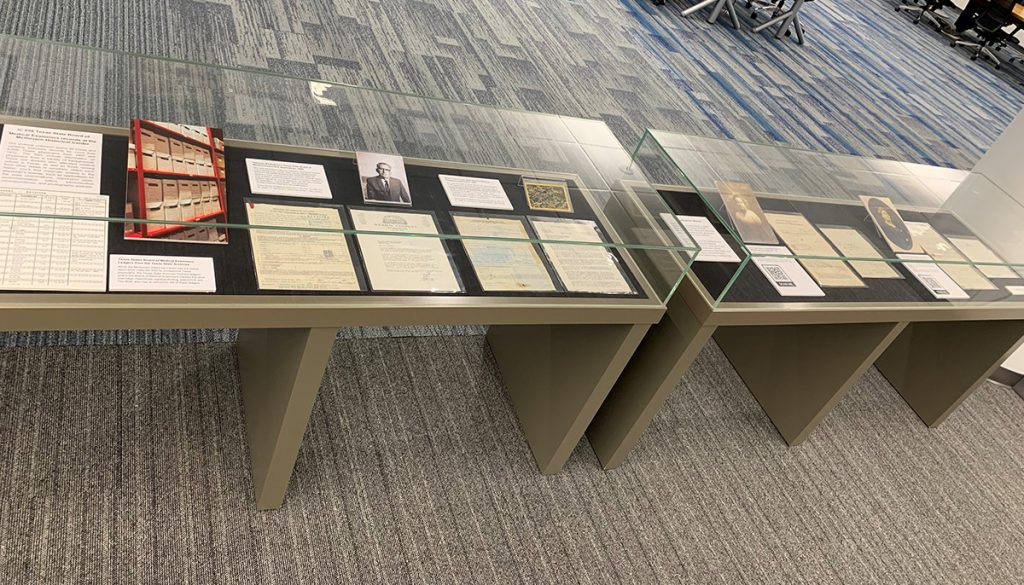by Matt Richardson, Archivist and Special Collections Librarian
If you find yourself in the TMC Library (and we hope you will!), you’ll notice a new exhibit showcasing materials from the McGovern Historical Center.
This exhibit highlights our extensive Texas State Board of Medical Examiners records (IC 058). If that sounds familiar, it may be because we’ve written about this collection a few times recently. It keeps getting our attention, and we thought other folks might like a peek at it, too. The current display builds on the research Shannon Wood did while completing her Master of Library Science practicum at the MHC. You may recall she’d researched and written about Drs. Carrie Jane Sutton and Petra Bonilla Toral de Colunga.
In this exhibit we’re featuring them, while also introducing the collection itself, and highlighting two more physicians whose stories stood out. Though they were applying to the Texas State Board back in the 1950s and 1960s, Heisiquio Rodriguez’ and Moore Yen’s stories highlight themes that continue to resonate today.
Hesiquio Rodriguez lived in Rio Grande City, Texas, and letters from his application file stress the “extreme need” for medical practitioners in their underserved area. There’s even a petition signed by dozens of local residents on his behalf. One advocate writes, “With the shortage of Doctors we have in Starr County, Dr. Rodriguez, who is very dedicated to his profession, would be a tremendous asset, and would certainly be of great assistance to the three Doctors that we have in this county, namely; Dr. Mario E. Ramirez, who is also our County Judge, Dr. Rene A. Solis, who is also our Sheriff, and Dr. Ramiro Narro, who is also our County Health Doctor.” This was in 1969.
![Dr. Hesiquio Rodriguez’ Texas State Board of Medical Examiners Application, 1969. [IC058-b76f27rFOC-002, McGovern Historical Center, TMC Library]](http://library.tmc.edu/mcgovern/wp-content/uploads/sites/5/2022/07/IC058-b76f27rFOC-002.jpg)
Moore Yen was a professor in the Department of Anesthesiology at the University of Texas Medical Branch at Galveston (unfortunately, his file does not contain a photo). He initially came to Texas from China in 1948 for his postgraduate training. However, a recommender notes, “At that time you will recall the whole political situation in China changed violently and this was followed shortly thereafter by the Korean crisis. It was impossible for him to return home, and the State Department allowed him an extension of stay in this country, the same courtesy offered to many others in his dilemma. He was granted permanent immigration papers shortly thereafter and is now a citizen of the United States.”
![Galveston's Medical Center, 1952. [IC091-galv_17, IC 091 Texas Healthcare Facilities Postcards, McGovern Historical Center, TMC Library]](http://library.tmc.edu/mcgovern/wp-content/uploads/sites/5/2022/07/IC091-galv_17.jpg)
Stories like these offer us historical perspectives on timely themes like regional healthcare disparities, migration, and dislocation. The archivists at the MHC have only explored a handful of the 6,000+ doctors’ stories contained with these records. We eagerly await learning what else researchers will uncover–and we hope this new exhibit will help folks come up with new questions to ask!
Due to the nature of this collection, we tend to have information about the doctors’ background and qualifications up to the point that they apply for Texas licensure. Looking at license renewal cards within these files, we can typically confirm that a doctor’s application was successful and can often establish an approximate date of death. As Shannon’s blog posts demonstrate, further research beyond our collections has the potential to uncover the contributions these Texas doctors made as their careers progressed. In the case of Dr. Yen, we know from his file that he died in 1964. But a quick Google search reveals that his Galveston home continues to attract attention from fans of modern architecture.
One of my favorite things about this collection is way it illuminates people’s travels—the ways their lives and careers evolve over time and move across geographies. Drs. Rodriguez and Yen came to Texas from Mexico and China, respectively. Dr. Toral de Colunga also came from Mexico, but studied in Michigan and Ohio before returning to Mexico, moving to Texas, and eventually heading to Illinois. Dr. Sutton was born in Texas, studied in Washington, D.C, and Pennsylvania, returned to Texas, moved to New Jersey, and then finally returned to Texas to stay. Ledgers from the Texas State Board of Medical Examiners showing where physicians attended medical schools illustrate that these patterns of movement—at least across states, if not internationally—were common among applicants. Broadening our view beyond individual stories, then, this set of records offers a window into the geographical demands of professional training, and likewise offers a way of mapping out migrations across the twentieth century United States—a map in which many roads lead through Texas.


